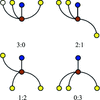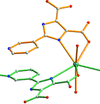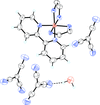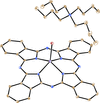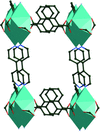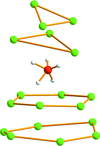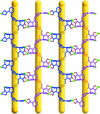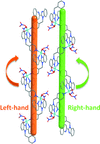issue contents
May 2014 issue

Cover illustration: Pseudo-hexagonal packing in the crystal structure of tetraethylammonium tetrachloridoferrate(III) at 110 K. See Lutz, Huang, Moret & Klein Gebbink [Acta Cryst. (2014), C70, 470-476].
research papers
Download citation


Download citation


Three soft scorpionate coordination complexes of alkali metals are presented together with an overview of the structural preferences of alkali metal soft scorpionate complexes. This analysis suggests that these thione-based ligands will continue to be a rich source of interesting alkali metal motifs worthy of isolation and characterization.
Download citation


Download citation


Hydrothermal synthesis yields a one-dimensional lead(II) coordination polymer of 5-carboxy-2-(pyridin-3-yl)-1H-imidazole-4-carboxylate, in which aromatic stacking and hydrogen bonds lead to a three-dimensional supramolecular architecture.
CCDC reference: 994109
Download citation


Download citation


Two new diamagnetic FeII coordination compounds are ionic, with distorted octahedral [Fe(phen)3]2+ or [Fe(bpy)3]2+ complex cations (phen is 1,10-phenanthroline and bpy is 2,2′-bipyridine) and two uncoordinated planar tricyanomethanide (tcm) counter-anions balancing the positive charges of the cations. The structures are stabilized by π–π interactions between stacked aromatic rings of adjacent phen molecules and by O—H⋯N hydrogen bonds.
Download citation


Download citation


In a complex salt composed of an [Fe(CN)5(pyrazole)]2− dianion and two 1H-pyrazol-2-ium cations, the dianion is a mononuclear cluster in which the FeIII cation is coordinated by five cyanide ligands and by one of the N atoms of a pyrazole ligand. A three-dimensional supramolecular network is formed through a rich scheme of N—H⋯N hydrogen bonds and C—H⋯π interactions among the cations and anions.
CCDC reference: 994457
Download citation


Download citation


In a two-dimensional cobalt(II) coordination polymer of benzene-1,2-dicarboxylate and 4,4′-bipyridine, interplanar cohesion is achieved via oligomeric solvent water clusters.
CCDC reference: 994191
Download citation


Download citation


An organic–inorganic hybrid complex consists of hydrogen-bonded 2-methylpiperazinediium cations in the presence of one-dimensional polymeric {[CdCl3(μ3-Cl)]2−}n anions. The CdII centres are hexacoordinated by three terminal chlorides and three bridging chlorides and have a slightly distorted octahedral arrangement.
CCDC reference: 993495
Download citation


Download citation


The molecular structure of high-spin (S =  ) manganese(II) bromide phthalocyanine as the tetrabutylammonium salt has been determined. The geometry of the MnIIN4 fragment in this salt is similar to that of the high-spin (S =
) manganese(II) bromide phthalocyanine as the tetrabutylammonium salt has been determined. The geometry of the MnIIN4 fragment in this salt is similar to that of the high-spin (S =  ) manganese(II) tetraphenylporphyrin complex with 1-methyimidazole.
) manganese(II) tetraphenylporphyrin complex with 1-methyimidazole.
CCDC reference: 984286
Download citation


Download citation


A novel nitride was synthesized from Sr3N2, EuN, Si3N4, AlN and BN under nitrogen gas pressure. The structure consists of a host framework with Sr/Eu atoms accommodated in the cavities. The host framework is constructed by the linkage of MN4 tetrahedra (M = Si, Al) and BN3 triangles, and contains substitutional disorder described by the alternative occupation of B2 or Si2N on the (0, 0, z) axis.
CCDC reference: 995203
Download citation


Download citation


In the crystal structures of two crown-ether-coordinated caesium halogen salt hydrates, hydrogen bonds between bromide ligands and water molecules lead to one-dimensional chains running along the b axis in one compound, whereas two-dimensional sheets of water molecules and chloride ligands are formed which combine with the polymeric caesium–crown polymer to give a three-dimensional network in the other complex. Although both compounds have a similar composition, i.e. a Cs+ cation with a halogen, an 18-crown-6 ether and a water ligand, the crystal structures are rather different. [OK?]
Download citation


Download citation


Fc(PSPh2)(CH2SPSPh2), a new chiral ferrocenyl (Fc) compound, is the precursor to a new P,S-coordinating ferrocenyl ligand, [Fc(PPh2)(CH2S)]−, which reacts with Pd and Pt precursors giving dinuclear complexes displaying a butterfly geometry.
Download citation


Download citation


Multiple hydrogen bonds in tris(2,2′-bipyridine)iron(II) bis(1,1,3,3-tetracyano-2-ethoxypropenide) link water molecules, anions and chiral cations into two interpenetrating chiral frameworks.
CCDC reference: 996644
Download citation


Download citation


At room temperature, tetraethylammonium tetrachloridoferrate(III) has a disordered structure in the high-hexagonal space group P63mc. At 230 K, the structure is merohedrally twinned in the low-hexagonal space group P63. At 170 and 110 K, the structure is identical in the orthorhombic space group Pca21 and twinned by reticular pseudomerohedry. All three space groups are polar and the direction of the polar axis is not affected by the twinning.
Download citation


Download citation


The new pentahydrate of bis(2,2′-bipyridine)oxalatonickel(II) was obtained from a reaction at 281 K, whereas the previously reported tetrahydrate was obtained at room temperature. The complex molecules are involved in an extended system of hydrogen bonds with solvent water molecules. Additionally, π–π interactions also contribute to the stabilization of the extended structure.
CCDC reference: 995367
Download citation


Download citation


The Se⋯O distance of 2.302 (3) Å in the title compound, combined with a longer than usual amide C=O bond of 2.252 (5) Å, suggest a significant interaction between the amide O atom and its adjacent Se atom. An analysis of related structures containing an Se—Se⋯X unit (X = Se, S, O) shows a strong correlation between the Se—Se bond length and the strength of the Se⋯X interaction.
CCDC reference: 996895
Download citation


Download citation


A novel infinite two-dimensional cadmium(II) polymer and a one-dimensional cobalt(II) polymer constructed by benzene-1,4-dicarboxylate ligands are formed. The two complexes are finally assembled to form three-dimensional network structures.
Download citation


Download citation


The comparison of the crystal structures of 5-(4-nitrophenyldiazenyl)salicylic acid and two related salts shows that the intramolecular O—H⋯O hydrogen bonds in the anions are stronger than that in the neutral molecule. The nitrophenyldiazenyl and carboxylic acid/carboxylate groups in the neutral molecule and the sodium salt are located anti to each other, whereas in the ammonium salt, the anion adopts a syn conformation.
Download citation


Download citation


In a novel three-dimensional ZnII complex prepared by the solvothermal assembly of Zn(NO3)·6H2O, naphthalene-1,4-dicarboxylic acid (1,4-H2ndc) and 4,4′-bipyridine (bpy), the two crystallographically independent Zn atoms adopt the same four-coordinated tetrahedral ZnO3N geometry. The supramolecular secondary building unit (SBU) is a distorted paddle-wheel-like {Zn2(COO)2N2O2} unit and these units are linked by 1,4-ndc ligands within the layer to form a two-dimensional net parallel to the ab plane, which is further connected by bpy ligands to give rise to a three-dimensional framework.
CCDC reference: 997212
Download citation


Download citation


Two novel polymers exhibiting metal–organic frameworks (MOFs) have been synthesized by the combination of a metal ion with benzene-1,3,5-tricarboxylic acid and 1,10-phenanthroline under hydrothermal conditions. The overall topology of the ZnII MOF is that of a 63 net and that of the MnII MOF is a rutile net.
Download citation


Download citation


The structures of two new electroneutral (pentafluoroethyl)phosphane-ligand-containing Mo complexes are reported. Key distance and angle values are compared with those of similar complexes.
Download citation


Download citation


In the crystal structure of (H3O)2NaAl3F12, the hydrogen bonding of H3O+ cations with F− anions implies a strong tilt of the AlF6 octahedra from the normal to the plane of the corrugated [AlF4−]n HTB (hexagonal tungsten bronze) layers.
CCDC reference: 999092
Download citation


Download citation


A new two-dimensional cadmium(II) coordination polymer containing 44-membered metallamacrocycles and helical chains has been prepared under solvothermal conditions using flexible 2,2′-(disulfanediyl)dibenzoate and 1,10-phenanthroline ligands.
CCDC reference: 998714
Download citation


Download citation


Two different one-dimensional supramolecular chains with CoII cations have been synthesized based on the semi-rigid ligand 2-[1-(pyridin-4-ylmethyl)-1H-benzimidazol-2-yl)quinoline (L), obtained by condensation of 2-(1H-benzimidazol-2-yl)quinoline and 4-(chloromethyl)pyridine hydrochloride, and the precursors Co(NO3)2 and CoCl2.


 journal menu
journal menu











